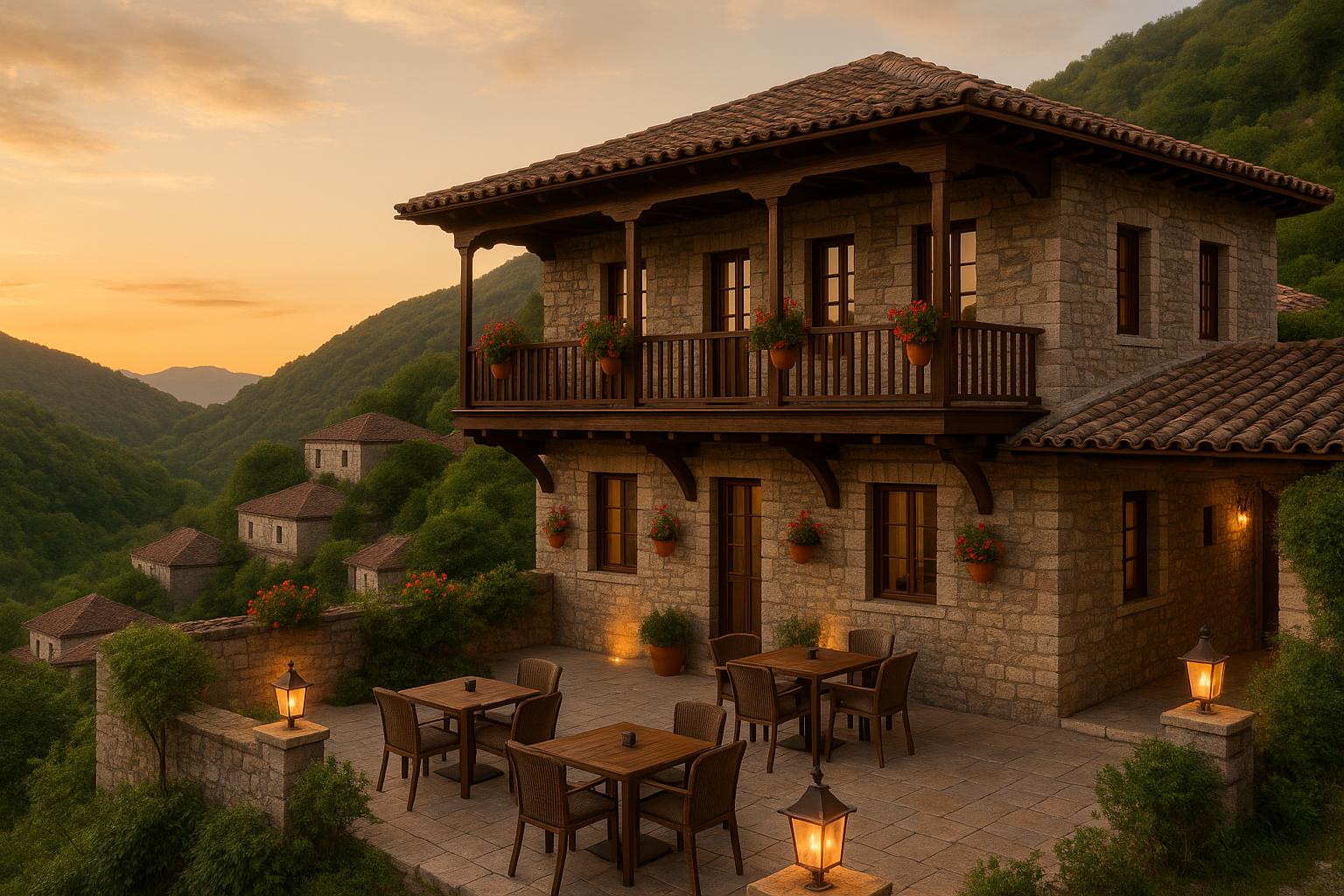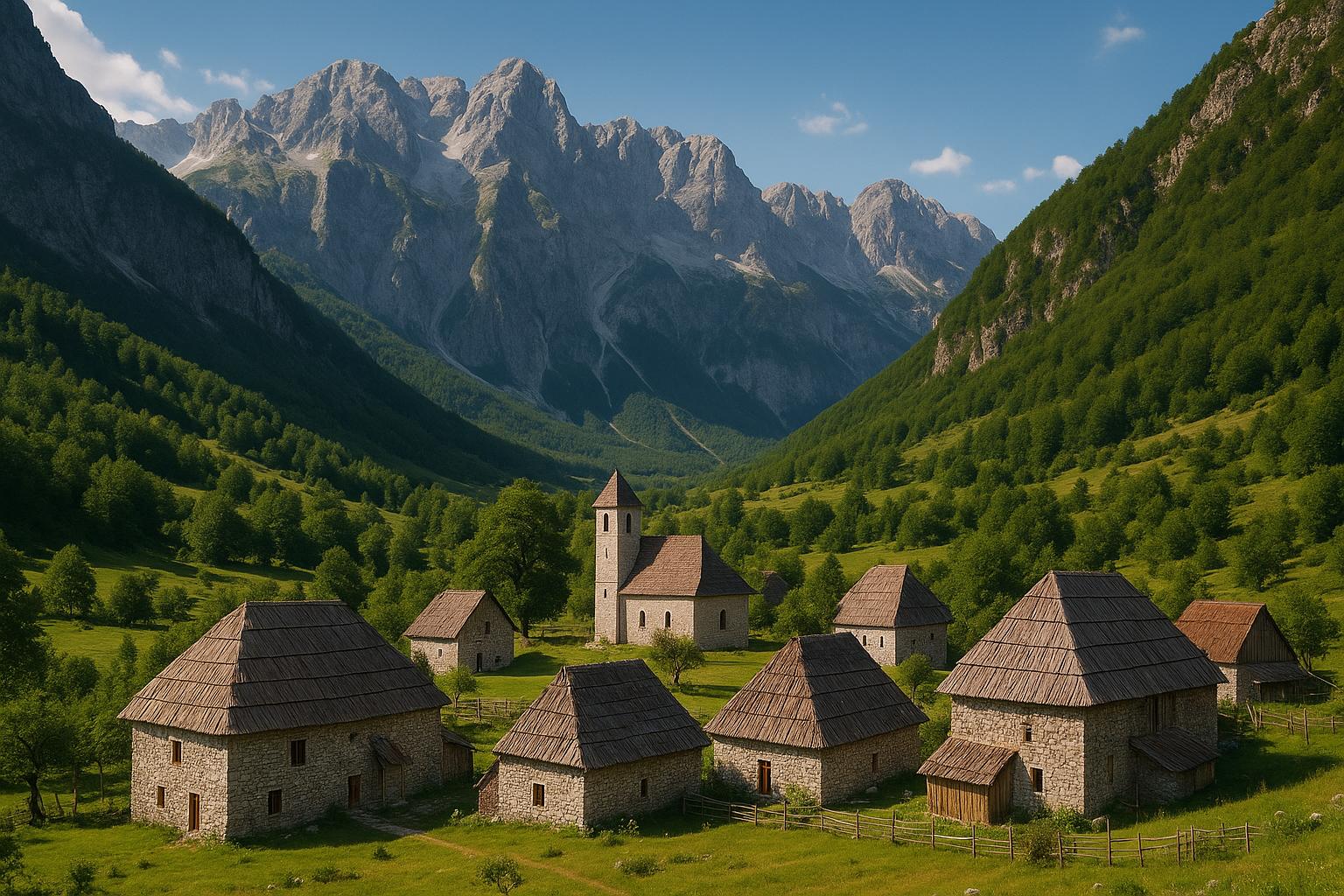Djall and Dreq are two key figures in Albanian mythology, both representing evil but with distinct origins and characteristics. While Djall comes from the Latin word diabolus (devil) and is depicted as a fiery demon, Dreq originates from the Latin draco (dragon) and carries dragon-like, serpentine traits. Despite their shared role as symbols of malevolence, they differ in their imagery and cultural roots.
- Djall: Fire demon, symbolizing destruction and moral decay.
- Dreq: Dragon-inspired, tied to serpentine power and consuming forces.
- Both challenge heroes in folklore, emphasizing bravery and moral strength.
Quick Comparison
| Aspect | Djall | Dreq |
|---|---|---|
| Etymology | From Latin diabolus (devil) | From Latin draco (dragon) |
| Appearance | Fiery demon | Dragon-like, serpentine |
| Role in Folklore | Adversary testing bravery | Antagonist with destructive power |
These figures reflect Albania's blend of pre-Christian and Christian influences, showcasing the duality of good and evil in its folklore.
Origins and Etymology
The origins of Djall and Dreq offer a fascinating glimpse into how ancient traditions intertwined with Latin and Christian influences to shape Albanian folklore. By tracing their linguistic roots, we can better understand the unique roles these figures play in Albanian culture.
Djall has its roots in Latin. As Vladimir Orel points out, “The name djall derives from the Latin diabolus, 'devil'”. This connection highlights how the arrival of Christianity introduced new mythological concepts and vocabulary into Albanian traditions.
On the other hand, Dreq (or Dreqi) follows a different path. According to Robert Elsie, “Alternative forms are dreqi from the Latin draco, 'dragon', satan and shejtan”. While its link to dragons suggests ties to older, pre-Christian beliefs, these meanings were later reinterpreted through a Christian lens.
These linguistic developments align with broader patterns in Albanian, which reflect ancient Paleo-Balkanic and Illyrian traditions. Over time, both terms evolved, blending pre-Christian and Christian influences into a uniquely Albanian mythological framework.
Modern Albanian expressions also illustrate how these terms remain culturally significant. For instance, phrases like dreqi me të birin incorporate dreq in ways that parallel similar uses of djall. In many cases, Dreq is portrayed as a destructive or consuming force.
This linguistic and cultural evolution showcases a rich fusion of traditions. The coexistence of Djall and Dreq underscores how Christian elements merged with older local beliefs, creating a dynamic and layered mythological landscape.
1. Djall
Attributes
Djall is the embodiment of evil, posing a threat to both physical well-being and spiritual integrity. Often portrayed as a fire demon, its elemental connection to fire amplifies its terrifying presence. Unlike the idea of evil as a vague concept, Djall takes on a vivid, fiery form that endangers not only moral principles but life itself.
Roles in Folklore
In Albanian folklore, Djall often plays the role of the ultimate adversary, challenging heroes to prove their bravery and moral fortitude. These stories serve as moral allegories, urging characters - and by extension, listeners - to confront the darker, more destructive sides of human nature. Through these encounters, virtues like courage, wisdom, and moral resilience are celebrated.
Symbolism
Djall stands as a powerful symbol of the eternal struggle between good and evil. Its fiery essence represents a force of destruction with tangible effects, serving as a stark reminder that evil is not just an abstract idea but a real and dangerous presence. This duality emphasizes the impact of moral failings on both individuals and communities. Up next, we’ll explore Dreq to uncover how its mythological traits differ from Djall.
2. Dreq
Etymology
The name Dreq - or Dreqi - traces back to the Latin word draco, meaning "dragon". This etymological root introduces a fascinating layer of mythological distinction compared to Djall, reflecting two separate yet intertwined associations in Albanian folklore.
Attributes and Roles in Folklore
In Albanian tales, Dreq is portrayed as a fire demon, a figure deeply tied to the concept of evil. Often cast as an antagonist, it challenges moral boundaries and tests the resolve of heroes. Interestingly, Dreq and Djall are sometimes used interchangeably in stories, hinting at their shared purpose in pushing protagonists to confront their virtues and flaws. This overlap adds complexity to the narrative while highlighting the nuanced roles these figures play in folklore.
Symbolism
The symbolism of Dreq is a blend of its origins and its portrayal. Its name connects it to the mythical dragon, a creature often associated with power and destruction. At the same time, its depiction as a fire demon reinforces its role as a manifestation of evil. Together, these elements create a multi-faceted character that stands apart from Djall, offering a distinct symbolic presence in Albanian mythology.
sbb-itb-dfcc1b7
Key Differences and Similarities
Djall and Dreq are both central figures in Albanian mythology, embodying the concept of evil. Despite their shared role as representations of malevolence, they are distinct in their origins and symbolic traits, which adds complexity to their portrayal.
Djall traces its roots back to the Latin word diabolus, meaning "devil", and is often depicted as a fiery demon. On the other hand, Dreq derives from the Latin draco, meaning "dragon", and is characterized by its dragon-like, serpentine features. These linguistic origins play a significant role in shaping their unique identities, even though their overarching purpose as symbols of evil remains similar.
Both figures serve as antagonists in Albanian folklore, embodying the pervasive and inevitable nature of evil. As one scholar aptly put it, "Djall or Dreq is the personification of evil in Albanian mythology and folklore". Their contrasting imagery, however, allows for diverse storytelling. Djall's fiery essence aligns with traditional devil imagery, while Dreq's serpentine characteristics evoke a mystique tied to dragons and serpents. This duality provides storytellers with a rich palette of symbolism.
Here’s a brief comparison of their key traits:
| Aspect | Djall | Dreq |
|---|---|---|
| Etymology | From Latin diabolus ("devil") | From Latin draco ("dragon") |
| Primary Representation | Demon linked to fire | Dragon-like, serpent-inspired entity |
| Symbolic Role | Personification of evil | Personification of evil |
| Interchangeability | Sometimes used interchangeably | Sometimes used interchangeably |
Together, Djall and Dreq highlight the layered and multifaceted nature of evil in Albanian folklore. Their distinct yet overlapping characteristics enrich the mythological narratives, offering a deeper understanding of the dualistic themes that run through these cultural stories.
Conclusion
The comparison between Djall and Dreq highlights the intricate layers of Albanian mythology, where these two figures represent the timeless battle between good and evil. Their distinct origins - Djall tied to fiery, devilish imagery and Dreq linked to dragon symbolism - showcase the blend of influences that have shaped Albanian folklore over time. This mix of elements not only enriches the mythology but also offers insight into their lasting impact.
These mythological characters illustrate how ancient traditions have adapted and endured across centuries of shifting beliefs. Djall is often depicted as a fiery demon, while the name Dreq carries associations with dragons. As central antagonists in many folk tales, they underscore values like bravery and moral strength.
Djall and Dreq remain deeply relevant in modern Albanian culture, reflecting the ongoing dualistic themes of good versus evil that are central to the nation's myths and legends. Their stories, passed down orally for generations, are especially alive in Albania's mountainous areas. This enduring tradition not only keeps the figures of Djall and Dreq vivid but also helps preserve Albanian identity and its moral heritage for future generations.
FAQs
What do the figures of Djall and Dreq reveal about the blend of pagan and Christian influences in Albanian mythology?
The characters of Djall and Dreq in Albanian mythology offer a glimpse into the blend of ancient pagan traditions and Christian elements. Djall is often portrayed as a sly, mischievous spirit, rooted in pre-Christian folklore. This figure represents themes of trickery and transformation, reflecting the deep roots of Albania’s pagan heritage.
Meanwhile, Dreq is typically linked to malevolent forces, showcasing how Christian ideas of evil intertwined with older pagan notions of spirits and deities. Together, these figures reveal Albania’s layered spiritual history, where ancient traditions and Christian influences merge to shape a distinct mythological identity.
What are the differences between Djall and Dreq in Albanian folklore, and how do they shape traditional stories?
In Albanian folklore, the Djall is often seen as a representation of chaos and evil, embodying malevolent forces that test virtues such as courage and wisdom. It symbolizes destruction and temptation, reflecting the darker sides of human nature and the struggles within.
On the other hand, the Dreq is associated with more vivid and unsettling imagery. It’s depicted as a sinister figure, sometimes imagined wearing the skin of the dead. This character is deeply tied to fear and wickedness, often serving as a cautionary figure in stories designed to teach moral lessons.
Both figures play crucial roles in Albanian storytelling, acting as adversaries or moral foils that emphasize values like bravery, resilience, and the ultimate victory of good over evil. These characters remain central to Albanian myths, underscoring the enduring themes of morality and the timeless battle between light and darkness.
What is the difference between Djall and Dreq in Albanian mythology, and why are they often seen as similar?
In Albanian mythology, Djall and Dreq are both seen as symbols of evil and chaos, often used interchangeably in folklore. Their names trace back to Latin roots: Djall originates from diabolus (devil), while Dreq comes from draco (dragon). Though they share similarities as fiery, demonic figures, their roles diverge slightly - Djall is typically linked to deception and cunning, whereas Dreq represents raw, destructive force.
This blending of traits underscores their shared role as archetypes of malevolence rather than distinct individuals. By intertwining these figures in myths, Albanian folklore emphasizes the timeless struggle between good and evil, using them more as symbolic representations than literal beings.


